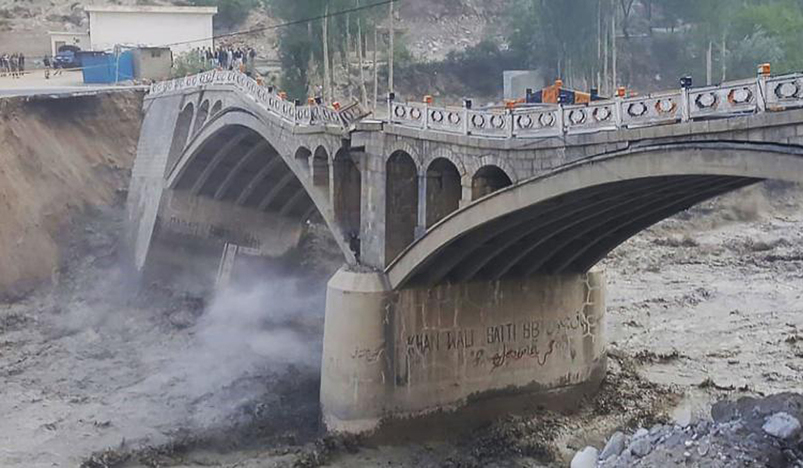
Pakistan Floods
Pakistan is home to more glaciers than anywhere in the world outside the polar regions, but as the climate warms, it's becoming more vulnerable to sudden outbursts of melting glacier water that have the power to bring widespread destruction to its people.
The country's chief meteorologist has warned that this year alone, Pakistan has seen triple the usual amount of glacial lake outbursts -- a sudden release of water from a lake fed by glacier melt -- that can cause catastrophic flooding.
Sardar Sarfaraz from Pakistan's Meterological Department said Thursday that there have been 16 such incidents in the country's northern Gilgit-Baltistan region in 2022, compared with just five or six seen in previous years.
"Such incidents occur after glaciers melt due to [a] rise in temperature," Sarfaraz told Reuters, adding: "Climate change is the basic reason for such things."
Melting glaciers is one of the clearest, most visible signs of the climate crisis and one of its most direct consequences.
It's unclear how much Pakistan's current flooding crisis might be connected to glacial melt. But unless planet-warming emissions are reined in, Sarfaraz suggests that the country's glaciers will continue to melt at speed.
"Global warming will not stop until we curtail greenhouse gasses and if global warming does not stop, these climate change effects will be on the rise," he said.
Pakistan is responsible for less than 1% of the world's planet-warming gases, according to European Union data, yet it is the eighth most vulnerable nation to the climate crisis, according to the Global Climate Risk Index.
That vulnerability has been on display for months, with record monsoon rains and melting glaciers in the country's northern mountains triggering floods that have killed at least 1,191 people -- including 399 children -- since mid-June.
New flooding fears
On Thursday, southern Pakistan braced for more flooding as a surge of water flowed down the Indus river, compounding the devastation in a country a third of which is already inundated by the climate change induced disaster.
The United Nations has appealed for $160 million to help with what it has called an "unprecedented climate catastrophe."
"We're on a high alert as water arriving downstream from northern flooding is expected to enter the province over the next few days," the spokesman of the Sindh provincial government, Murtaza Wahab, told Reuters.
Wahab said a flow of some 600,000 cubic feet per second was expected to swell the Indus, testing its flood defences.
Pakistan has received nearly 190% more rain than the 30-year average in the quarter from June to August, totalling 390.7mm (15.38 inches).
Sindh, with a population of 50 million, has been hardest hit, getting 466% more rain than the 30-year average.
Some parts of the province look like an inland sea with only occasional patches of trees or raised roads breaking the surface of the murky flood waters.
Hundreds of families have taken refugee on roads, the only dry land in sight for many of them.
Villagers rushed to meet a Reuters news team passing along one road near the town of Dadu on Thursday, begging for food or other help.
The floods have swept away homes, businesses, infrastructure and roads. Standing and stored crops have been destroyed and some two million acres (809,371 hectares) of farm land inundated.
The government says 33 million people, or 15% of the 220 million population, have been affected.
The National Disaster Management Authority said some 480,030 people have been displaced and are being looked after in camps but even those not forced from their homes face peril.
"More than three million children require humanitarian assistance and at increased risk of waterborne diseases, drowning and malnutrition due to the most severe flooding in Pakistan's recent history," the UN children's agency warned.
The World Health Organization said that more than 6.4 million people desperately needed humanitarian aid.
Aid has started to arrive on planes loaded with food, tents and medicines, mostly from China, Turkey and United Arab Emirates.
Aid agencies have asked the government to allow food imports from neighboring India, across a largely closed border that has for decades been a front line of confrontation between the nuclear armed rivals.
The government has not indicated it is willing to open the border to Indian food imports.
CNN's Angela Dewan and Azaz Syed contributed reporting.
.jpg)
Qatar Secures Place Among the World's Top 10 Wealthiest Nations
.jpg)
Hamad International Airport Witnesses Record Increase in Passenger Traffic

Saudi Arabia: Any visa holder can now perform Umrah

What are Qatar's Labour Laws on Annual Leave?
Leave a comment